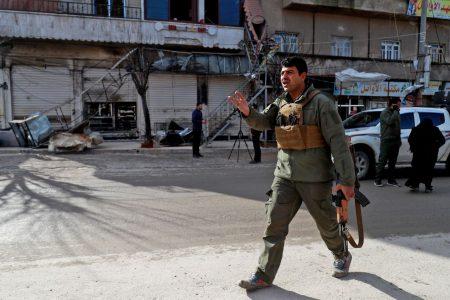
Islamic State changes battlefield tactics to guerrilla warfare after losing territory
The Islamic State command is calling for a big shift in battlefield tactics to guerrilla warfare, acknowledging that the U.S.-led coalition’s precise air campaign is methodically picking apart its clustered forces.
A retired U.S. Army infantryman told The Washington Times that the new tactics may well be preparation for a metamorphosis. Islamic State will transform itself from an occupation force defending territory to an insurgency trying to undermine the authority of the governments of Iraq and Syria.
The marching orders are contained in the Islamic State’s authoritative Al-Naba publication, which regularly releases guidance to fighters trying to retain the terrorist army’s weakening hold on land and people.
Islamic State terrorists have been in retreat for months. The predominantly Kurdish Syrian Democratic Forces — advised by American special operations forces and guided by blanket aerial surveillance — have taken large swaths of territory and liberated almost all of Raqqa, Islamic State’s proclaimed capital in central Syria. With Syrian government forces besieging the city on another front, an SDF military commander this week told The Associated Press that the fight to retake Raqqa was “in its final stages.”
The Al-Naba directive is headlined, “How Do We Fight Under the Watchful Eye of the Crusader Planes?” according to a translation by the Middle East Media Research Institute, which monitors jihadi media.
The article discloses a purported American/coalition tactic: The allies fire randomly to prompt Islamic State fighters to return bullets, which surveillance aircraft spot to pinpoint enemy positions. It also notes the role of ground spotters who conduct reconnaissance to find the exact GPS coordinates to call in air bombardment.
U.S. Central Command said it believes the coalition has killed thousands of Islamic State fighters.
The Islamic State publication said a big mistake for its fighters has been to try to hold territory using fortified stagnant positions, which make for easy air targets. The new orders tell followers to return to guerrilla-type warfare, staying on the move to ambush the allies while evading aerial detection.
Other new tactics outlined in the piece:
• Dispatch a drone to draw coalition fire to find the opposition’s location.
• Use more camouflage and cut back on supply deliveries.
• Reduce the number of fighters stationed on the front lines.
• Refrain from firing until coalition forces get close enough that allied aircraft will not risk bombing friendly troops.
“This is all good tactical advice and could ultimately help the jihadi to sustain an insurgency for a long period,” said Robert Maginnis, a retired Army colonel and counterterrorism author.
“ISIS is exercising good operational security given the nature of its enemy and its decreased capabilities,” he said. “It must minimize its exposure to enemy detection in order to survive and continue to have a meaningful effect. Deception is key to survival for an insurgent force. ISIS will learn what draws fire without losses. That’s a lesson the Viet Cong learned to good effect against American forces during our long war.”
Al Naba had issued a string of upbeat reports as the Islamic State captured towns in Iraq and Syria while massacring innocents in 2015. But last year, the tone became less optimistic as the full force of American intelligence and pinpoint airstrikes, and a resurgent Iraqi army, notched one victory after another.
The U.S. became proficient at finding clusters of Islamic State fighters and tracking the exact movements of its leaders. On Sept. 4, a U.S. strike killed Islamic State’s top weapons researcher, Abu Ans al-Shami, as he rode on a motorcycle on a road near Mayadin, Syria.
Arab and Kurdish Democratic forces last week reached center city in Raqqa.
“The al-Naim traffic circle, once an ISIS symbol of fear and terror, where they held public executions, is now a fading propaganda setting, much like ISIS’s hollow caliphate,” said Army Col. Ryan Dillon, the command spokesman in Baghdad.
Islamic State’s main defense became not people but hundreds of planted improvised explosive devices.
“SDF fighters describe this struggle as much a fight against IEDs as it is against ISIS, with the sheer quantity of improvised explosive devices far exceeding anything the SDF had seen previously,” said Col. Dillon.
Source: Washington Times





